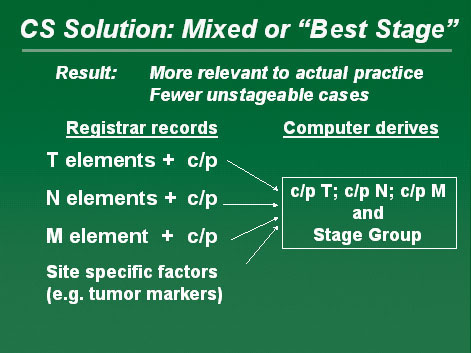CS Data Set & Collection
Important
These modules are archived and should only be referenced for historical purposes.
Technology
Collaborative Stage is a coding system, not a staging system. The structure of CS is adapted from SEER Extent of Disease Coding (EOD) using the AJCC 6th edition and SEER Summary Stage 2000. The final Stage is derived by computer algorithm provided in the cancer registry software program.
In Collaborative Staging, registrars code the "facts" about a case, including all elements to derive TNM and Summary Stage.
The computer algorithm is designed to generate the corresponding stage from the CS coded fields, using primary site code, histology code specific schemes based on ICD-O-3, as well as site-specific factors.
The same computer algorithms are used at both the hospital registry and the central registry to derive the stage from CS data elements.
Clinical and Pathologic Staging Basis
Collaborative Stage coding provides the information to generate staging TNM as pathological, clinical, or mixed stage.
View how TNM data is collected today—clinical and pathological data is not combined and as a result there are too many cases with unknown stages. There are two problems with this data collection method.
- Output must be "pure" clinical, "pure" pathological or unstageable.
- The Registry stores interpreted data, not facts.
On the other hand, with Collaborative Staging, clinical and pathological information can be combined to come up with a mixed or best stage.
Method of Evaluation as a Basis for Determining Stage
Collaborative Staging has added data items that capture the method used for the evaluation of the individual T, N, and M elements.
Collaborative Stage codes describe the facts about how the T, N, and M were determined, based on coded levels of pathologic and clinical information. For example, the abstractor codes that the T category was based on complete surgical resection (pathologic), CAT scan imaging or physical examination (clinical).
Collaborative Stage coding rules enable the registry to store fact-based codes, minimizing the variability that results from coding interpreted data.
What Collaborative Staging does is to provide a structure in which data collectors can enter the facts that will generate a T, N, M, and Stage Group. Registrars may have to learn to report facts in a new way but they will not have to make the decision about whether something is a T1 or T2. What the registrar does is enter the facts into the computer which will generate the T, N, M, and Stage Group.

Diagram showing the CS Solution, also known as Mixed or "Best Stage" to a TNM problem
Site-Specific Factors
Site-Specific Factors have been added to record the additional details necessary to derive the T, N, M, and Stage Group and the Summary Stage. For some sites, the site-specific factors expand the use of anatomic and prognostic factors specific to cancer sites and histologies that affect the cancer stage. Each of the six site-specific factors has a three digit data field.
Collaborative Staging Data Items
There are fifteen items in CS data set. In addition to five existing data items (tumor size, extension, and lymph node items), there are ten new data items including metastases at diagnosis, three "methods of evaluation (TNM)," and six site specific factors.
Three new fields were used to identify the method of staging (clinical vs. pathological). Site specific factors allow for the collection of biomarkers and other factors in staging, for example, A/B symptoms in lymphoma, or LDH levels in Melanoma.
View the table that shows the fifteen CS data items.
Suggested Citation
SEER Training Modules: CS Data Set & Collection. U.S. National Institutes of Health, National Cancer Institute. Cited 30 December 2025. Available from: https://training.seer.cancer.gov.




